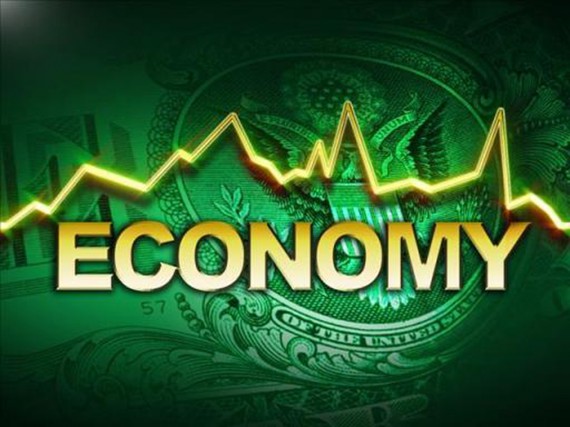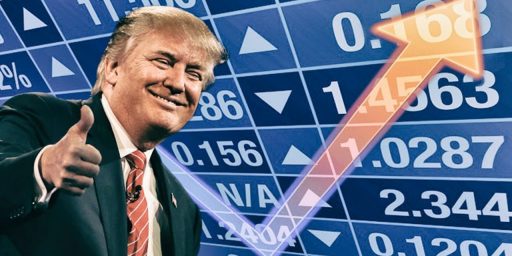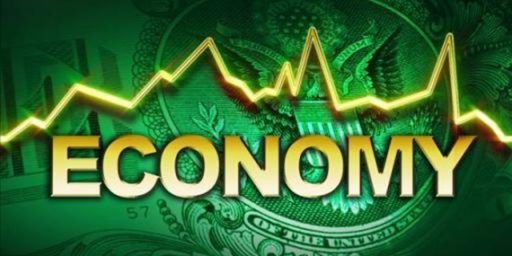GDP And Durable Goods Figures Spell Bad News For The Economy
Newly released statistics indicate that the economy is slowing down and in danger of slipping into a recession.
The Commerce Department came out with its final revision for Gross Domestic Product Growth in the second quarter, and the numbers were not good at all:
The United States economy grew at an even more sluggish pace in the April-June quarter than previously believed, the Commerce Department said Thursday, as farm production in the Midwest was reduced by a severe drought.
The government said the overall economy grew at an annual rate of 1.3 percent in the spring, down from its previous estimate of 1.7 percent growth. The big revision reflected that the government slashed its estimate of crop production by $12 billion.
About half of the downward revision to growth came from the decline in farm inventories. But other areas were weaker as well, including slower consumer spending and less growth in exports.
The 1.3 percent growth in the spring followed a sluggish 2 percent growth rate in the first quarter, rates too slow to lower unemployment.
The economy received another piece of bad news this morning when it was reported that Durable Goods orders had dropped sharply:
New durable goods orders in August fell by the most since the recession and a separate reading on the broader U.S. economy came in much weaker than expected. But weekly jobless claims sank to a two-month low, in a hopeful sign for the labor market.
New orders for long-lasting U.S. manufactured goods in August fell by the most in 3 1/2 years, pointing to a sharp slowdown in factory activity even as a gauge of planned business spending rebounded.
The Commerce Department said on Thursday durable goods orders dived 13.2 percent, the largest drop since January 2009, when the economy was in the throes of a recession. Orders for July were revised down to show a 3.3 percent increase instead of the previously reported 4.1 percent gain.
Economists polled by Reuters had expected orders for durable goods — items from toasters to aircraft that are meant to last at least three years — to fall 5 percent.
Last month, the drop in orders reflected weak aircraft and automobiles demand. Boeing received only one aircraft order in August, down from 260 in July, according to information posted on the plane maker’s website.
Transportation equipment tumbled 34.9 percent after racing ahead 13.1 percent in July. Excluding transportation, orders fell 1.6 percent after dropping 1.3 percent the prior month. Economists had expected this category to rise 0.3 percent after a previously reported 0.6 percent fall.
Non-defense capital goods orders excluding aircraft, a closely watched proxy for business spending plans, rose 1.1 percent, halting two straight months of hefty declines. That was above economists’ expectations for 0.5 percent gain.
But shipments of these goods, which are used to calculate equipment and software spending in the gross domestic product report, fell 0.9 percent after declining 1.1 percent in July. The weakness suggested third-quarter economic growth would probably not improve much from the April-June’s 1.3 percent annual pace.
These numbers, especially the GDP figure (which was actually 1.25% but rounded up to 1.3%) suggests strongly that the recovery that started in 2009 is starting to run out of steam. Indeed, it now appears that we hit the high point of that recovery at the end of 2011 when GDP growth hit what was ultimately determined to be 4.1%. The first quarter of 2012 came in at 2.0%, and now we’re at 1.25%, which is barely growth at all. Current forecasts suggest that when the third quarter GDP number comes out in October it’s likely to be the 1.3% range as well, and there’s little sign that the fourth quarter, or the foreseeable future is going to be any better. The Durable Goods orders are also concerning because they indicate a massive downturn in manufacturing, the one sector of the economy that had been performing strongly even in the midst of the anemic growth we’ve been experiencing in 2012. If the bottom is falling out in that sector of the economy, it could end up throwing the rest of us into a recession regardless of what happens with the election and the so called “fiscal cliff.”
James Pethokoukis comments:
U.S. economic growth is dangerously slow. I’ve frequently written about research from the Fed that finds since 1947 when two-quarter annualized real GDP growth falls below 2%, recession follows within a year 48% of the time. (And when year-over-year real GDP growth falls below 2%, recession follows within a year 70% of the time.
Citigroup has also taken a shot at determining the stall speed: “Specifically, when U.S. growth has cut below 1½ percent on a rolling four-quarter basis, it has tended to fall by nearly 3 percentage points over the following four quarters, and the economy has typically entered recession.
Bottom line: Growth the past two quarters has averaged about 1.6%. Not only does this mean the economy is growing more slowly than last year’s 1.8%, it is also slow enough to signal about a 50% chance of a recession within a year. And the third quarter also looks weak.
In other words, the economy is growing so slowly at the moment that we are at significant risk of the entire thing stalling completely and throwing us into a recession.
The most immediately impact of all this will likely be that the jobs reports that will be released on October 6th and November 2nd are unlikely to be any better than what we’ve seen since April, with slow job growth and many people simply dropping out of the job market entirely. People giving up looking for work, in fact, may explain the drop initial jobless claims last week, which was the one piece of good news released today. What’s hard to tell, though, is what impact this might have politically. Logically, one would think that this would be good news for Mitt Romney and bad news for the President. However, recent polling has showed us both that the President has made up the deficit he had over the summer on economic issues and that the public has generally become more optimistic about the economy, even as the statistics show otherwise. So, we could end up with a situation where the bad economic news doesn’t end up hurting the President all that much, especially if the Romney campaign isn’t able to effectively exploit this information as a campaign issue.
Regardless of who wins the election, though, this news suggests that we’re headed for a grim winter and a grim start to 2013.





Given that I think slow to no growth is likely to continue for the foreseeable future, regardless of who is president, these figures come as no surprise to me. Romney can’t capitalize on them because all he’s offered is a return to Bush-era policies, and a majority still blame Bush for our current economic woes.
Hell, with Q2 GDP getting revised way down to 1.3% the next slate of polls from WaPo/CBS/NYT/Q will have Obama expanding his lead in Ohio and Florida. Seriously. And the most amazing irony with that? At a certain level there will be a sliver of truth to it. Misery loves company.
In any case, this is a good post and it covers most of the essential bases regarding GDP growth, but there are two much larger elephants in the room: the job market and inflation.
As bad as GDP growth is right now the job market is that much worse. Check out the figures for long-term unemployment (people who despite efforts have remained unemployed for more than 26 weeks). Four years ago, at the very apex of the financial crises, long-term unemployment stood at around 2 million. Now? Shit. Long-term unemployment today is over 5 million, has been over 5 million for more than three consecutive years, and is down from it’s recent peak principally because people in droves finally have given up looking, thereby taking themselves out of the measurement.
Then you have to consider inflation. Right now it’s not that horrible. But Bernanke’s Fed has jumped the shark tank and on the inflation front it simply won’t end well. What the hell will GDP look like when inflation rears its ugly head? Not a pretty picture. If the U.S. was a stock I’d be short selling it.
This is silly. The financial crisis was just hitting four years ago. Of COURSE long-term unemployment wasn’t high then. Why would it have been?
Agreed that the current figures are terrible.
Have you been one of those people freaking out about the inflation that is always coming but never seems to show up?
Or are you specifically tying this to the Fed’s recent policy shift?
I’m sure you can find a proxy or a mix of proxies for this and do that.
How you can type a post about weak GDP and not mention reduction in Government spending just f’ing baffles me. Government spending fell again in the second quarter…for the 11th straight quarter…dating back to when the stimulus started to phase out. This is the longest streak of Government shrinkage since 1947…and yet you don’t even consider mentioning it. Which is funny…because you are getting what you want…but you still ain’t satisfied. Anyone pretending to do political analysis…wondering what impact this might have politically…might ask what happens to the same weak economy when Romney cuts discretionary spending by an additional 20%? I would never expect that from you.
Four years ago, at the very apex of the financial crises, long-term unemployment stood at around 2 million. Now? Shit. Long-term unemployment today is over 5 million, has been over 5 million for more than three consecutive years, and is down from it’s recent peak principally because people in droves finally have given up looking, thereby taking themselves out of the measurement.
This kind of mindless idiocy is exactly why people are stuck with the choice of Barack Obama or Barack Obama. Four years ago, the world economy lost an enormous amount of capital. End story. The last four years have been the consequences. There’s plenty of bad things that are true to say about Obama, but you have none at all in your little head.
Reading these posts is getting to be like watching a bad comedian recycle the same unfunny material.
Lemme explain some Econ 101. The easiest way to calculate GDP is the Expenditures model: you add up C + I + G + X. That’s Consumer spending (reliably ~60-65% of our economy) plus business Investment spending (maybe 16-18%, but highly volatile) plus Government spending (federal, state and local; usually slightly less then I) plus net eXports (highly volatile, but usually quite small in relation to the others).
During a recession, when I drops sharply because of bearish businesses, the best thing to do is for the gov’t to actually _increase_ spending to take up the slack & stabilize the GDP growth rate. An important thing that often gets mixed up here – increasing G does not actually fix the economy. It just stabilizes things until the recession passes & business goes back to normal.
Unfortunately, economic incompetents and vulture capitalists have convinced everyone that increasing gov’t debt is worse than setting kittens on fire. Take a good look at Europe, especially the UK. Austerity is _destroying_ them because it _cannot_ bring back growth. Period. That’s why every single, solitary Republican idea about what to do for the US economy is utterly wrong and self-destructive.
The BLS report on Benchmark Revisions showed 485,000 additional private sector jobs from March ’11 to March ’12 over previously reported…but that 67,000 additional public sector jobs were cut. 67K…that’s the equivilant population of the Island of Kauai.
In total we have cut 633,000 government jobs since ’09…in Bush 43’s first term we added 700,000 government jobs. That’s a delta of 1.3 million jobs.
You want the economy back on track? Get Government hiring and spending back on track. And electing Romney isn’t going to do that if he’s going to slash discretionary spending by 20%.
The Econbrowser recession indicator index rests at 5.7%
(Gosh, if the sky was falling, wouldn’t that be higher?)
The chances of a recession are now entirely in the hands of expectations. If firms and households react negatively to this news and re-trench, it will reinforce the downward spiral and GDP may dip into negative territory. The country requires immediate and sustained stimulus, preferrably through a jobs guarantee to get twenty million unemployed back to work. By allowing this situation to drag on for years we’ve destroyed tremendous human capital and more every day.
Maybe its time to pay attention to economists like Krugman (who have gotten it right from Day One of the financial crisis)and talk about another round of fiscal stimulus ? FINALLY?
Spooked by the republicans, the administration made the exact same mistake the Roosevelt Administration did in 1936-pivot too soon to deficit reduction. The result then was a sharp slump in 1937-8.
Those who ignore history….
Expect Obama to push for stimulus after the election.
I dont want to even think of what Romney will do.
Just in the last day or two, consumer confidence, which tends to be a leading indicator, had its highest mark in a long time. GDP tends to be a lagging indicator, telling us more about the summer and less about the fall and beyond.
There is no doubt the recovery is anemic, and we all would have liked to see a more encouraging number here, but the balance of the evidence to me makes it look like a recession is not likely in the next year to 18 months unless there is another external shock.
@Curtis: Note that this coincides with a sudden and complete drop-out in Romney’s polling numbers. The idea of putting Republicans in office does not engender confidence in businesses or consumers. Keeping people like Mitt Romney out of power does. Remember that.
The real pain index is the cost of living and the government doesn’t say anything about all this stuff going up. Examples: price of gas, price of soft drinks, popcorn, Doritos and other chips, candy, bread, milk, and other food staples. Has our pay kept up? Don’t even ask. Many of the people who have gone back to work are working for less wages and benefits.
@Carson: the price of gas will continue to increase with increased demand. Witness China. Nothing much we can do about that–get a more efficient car, use public transportation, or bring out the horse-and-buggy again.
The rest? Frankly, if you consider potato chips and candy to be “staples” you’ve got a much bigger problem than your budget.
I just adopted the finished products after Friday, was introduced using the particular just and choosing a lump sum 1 single lb,hammer really. since i have have kids I avoid getting that foods sense in any respect. it could be a month and I choosing a lump sum 8lbs and much inches. not only the fat dramatically reduced, but will also the energy and i find that i’m far more concerned and am cease to lured to put things off the time away.